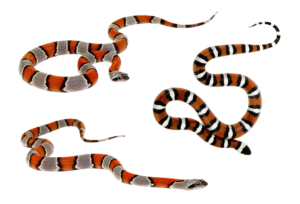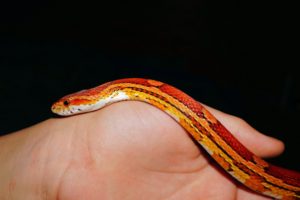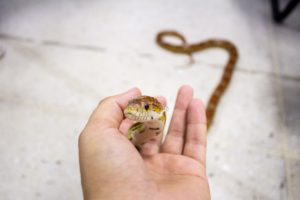There are over 3,000 species of snakes in the world, and learning them all can take ages. One snake that stands out to me, is the candy cane corn snake. What makes this snake so special, you ask?
Their diversity of colors is what makes the candy cane corn snake special.
I’ll tell you why and this article will cover it all!
Before we get started, I would like to mention what you’ll learn in this article:
- You’ll learn what a candy cane corn snake is.
- If you can keep them as pets.
- Raising them properly.
- Their growth size.
- And more!
Are you ready to learn about the candy cane corn snake? Let’s begin!
What is a Candy Cane Corn Snake?

Candy cane corn snakes are typically corn snakes with extraordinarily vivid and attractive colors. Many corn snakes are bred by owners.
Corn snakes are known as beginner snakes meaning it’s great for new interests that are wanting to keep them as pets.
It’s even better when you own a colorful candy cane corn snake!
Size of Candy Cane Corn Snake
When it comes to size, candy cane corn snakes can grow up to 54 inches long.
Here’s what you need to know about size:
- Baby candy cane corn snakes can range from 6 to 10 inches long.
- When they become adults, these snakes can range from 36 to 54 inches in length.
With such an adorable size for a snake pet, you should also keep in mind that their life span can range between 10 to 15 years.
Poisonous or…
Don’t be fooled! Corn snakes are probably one of the most harmless snakes you’ll encounter.
According to this informative post, it appears that many people have mistaken the corn snake as the copperhead. In fact, you’ll never want to encounter a copperhead snake.
Copperhead snakes are so deadly that their special venom can cause critical harm to your local tissues.
Yep, that’s one snake you’ll want to avoid.
As for the candy cane corn snake, they’re reluctant to bite. Overall, they’re not the type of snake to cause harm and can be great together with humans.
Can You Keep Candy Cane Corn Snakes As Pets?

Candy cane corn snakes are usually manageable, they’re not hard to care for, and they stay at a desirable size for snake owners. Because of their variety of colors, snake enthusiasts love raising them.
If you like holding onto your pets, then this type of snake is perfect for you. They can withstand long periods of you carrying them.
According to research, holding corn snakes shouldn’t take more than one hour. You should only be doing this 1-2 times weekly.
There are ways to tell if your candy corn snake is content with you. When your snake appears to be relaxed and calm, moving around at a slow rate, and wrapping itself around you – then it’s showing signs of calmness.
How Do You Raise Candy Cane Corn Snakes?

The first thing you should know is the amount of sunlight this snake requires!
Candy cane corn snakes should be given at least 10 to 12 hours of day/sunlight per day.
Caring For Baby Candy Cane Corn Snake
Before you get started with a baby candy cane corn snake, you should remember to have a container or a paludarium/terrarium that can fit a 10-gallon size.
Inside your corn snake’s home, you should have:
- Hiding places for your snake. This will keep the snake more comfortable when it wants to stay shelter.
- You’re going to want to add items for your snake to climb and wrap itself on. An example of this would be branches.
- Your corn snake’s home should be absolutely secured because they can potentially escape.
If you didn’t know, candy cane corn snakes prefer to hide and shelter themselves. Remember to keep the humidity of your tank at around 40% to 60%.
The Right Temperature
This is the temperature you should keep in mind before raising a candy cane corn snake.
- Day Time: During the day time, you should keep your snake’s environment at between 80 to 85 degrees Fahrenheit.
- Night Time: During the night time, you want to keep the temperature between 75 to 80 degrees Fahrenheit.
If you’re not sure how to check the temperature, you might want to click here to use these useful tools!
What Does a Candy Cane Corn Snake Eat?

Now that you’re all set, you’re probably wondering what a candy cane corn snake eats!
These snakes are carnivorous, which means that they will consume anything mammal-like or fish that are the perfect size for a meal.
The main type of food that these snakes can consume is usually mouse-sized.
Here’s a list of examples of what candy cane corn snakes will consume:
- Lizards
- Frogs
- Mice
There have been stories of people trying to feed candy cane corn snakes crickets, but they won’t recognize it as food. It’s better to feed them anything similar to the list above.
What Do You Think?

With over 3,000 species of snakes and a wide range of colors when it comes to the corn snake. What’s your view on the candy cane corn snake? Comment below this article!
In my opinion, the wide range of colors for this snake is amazing. It’s great for picky snake owners especially when it comes to colors.
The candy cane corn snake is definitely a unique kind of snake and one you should definitely take a look at.
I love the fact that they don’t grow too large otherwise it’d be a problem for pet owners with average size tanks.
From VivariumTips,
Hopefully, this candy cane corn snake guide gives you an idea and knowledge about the beauty of this creature. The world of snakes is massive and you’re missing out on a lot.
I know I am.
If you enjoyed this article, then you might also enjoy these animal-related posts that I created:
Not only that, but I’ve also created a really nice resource page for readers like you to find a community to join! You can find it here.
Most snake owners keep their pets inside a paludarium, which means it’s worth taking a look at my paludarium guide. (it could be beneficial to you in the long run)
Don’t forget to share this article, leave your feedback, and comment right below! 🙂

